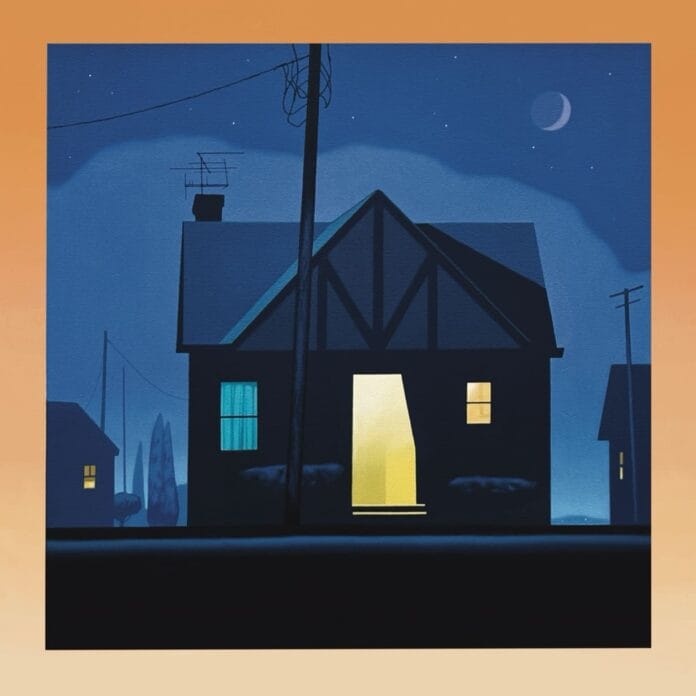In a world often overwhelmed by noise, distraction, and rapid change, the quietude found in Christopher Burk’s paintings offers a rare moment of stillness. A Columbus, Ohio-based artist, Burk has built a notable career on his ability to transform ordinary and overlooked landscapes into deeply contemplative visual experiences. His practice invites viewers to slow down, look again, and find resonance in the humble details of their environments.
A Painter Rooted in Place
Christopher Burk is not a landscape painter in the traditional sense. While his work depicts natural and suburban scenes, it avoids the grand or sublime. Instead, Burk focuses on the subtle, often unremarked features of the built and natural world: alleyways, utility poles, quiet suburban yards, bare trees against dusk skies. Through his careful compositions and serene palette, he elevates these everyday elements into meditative studies of space, time, and perception.
Living and working in Columbus, Ohio, Burk’s artistic sensibility is deeply shaped by the visual rhythms of the Midwest. Rather than chasing dramatic vistas, he finds inspiration in the visual language of the familiar — the interplay of geometry, structure, and nature that surrounds him.
Recognition and Residencies
Burk’s thoughtful approach to landscape painting has not gone unnoticed. He has been honored with a Visual Arts Fellowship from the Greater Columbus Arts Council and the Columbus Museum of Art, a testament to his regional impact. Nationally, he has received the prestigious Pollock-Krasner Foundation Grant — a significant recognition of his contributions to contemporary painting.
In addition to these accolades, Burk has received multiple Individual Excellence Awards from the Ohio Arts Council. These awards affirm both his artistic merit and his dedication to evolving his practice. His commitment to exploration and growth is further demonstrated by his participation in esteemed artist residencies, including the Josef and Anni Albers Foundation in Connecticut, the Vermont Studio Center, and the Greater Columbus Arts Council’s Dresden Artist Exchange program in Germany. These immersive experiences have informed his work by offering new perspectives, while also deepening his connection to his creative roots.
Philosophy of Perception
Burk’s artist statement reflects the core of his practice: “The search for new and distinctive forms and compositions in our outdoor environments is a central theme in my work.” For Burk, painting is not about replicating reality, but about re-seeing it — finding overlooked patterns, framing the mundane in ways that prompt reflection.
In his own words, “When those elements are presented in a unique way it allows viewers to connect with not only their environments but also the world at large — empowering individuals to find beauty in the simplest of things.” This philosophy aligns his work with a long tradition of artists who believe in the transformative power of close observation — from Giorgio Morandi’s bottles to Edward Hopper’s quiet streets.
Featured Work: Nocturne in Orange Square 1
One exemplary piece that encapsulates Burk’s approach is Nocturne in Orange Square 1, an oil painting on paper mounted on panel, measuring 18 by 18 inches. At first glance, the work appears simple. But upon deeper inspection, it reveals a mastery of tone, geometry, and atmosphere.
Set during twilight or early nightfall — suggested by the word “nocturne” — the painting captures a fleeting moment when light and color converge in a way that is both eerie and familiar. The “orange square” may refer to an architectural element, a glowing window, or simply a shape cast by light — its ambiguity is part of the piece’s power. Here, Burk channels the tradition of tonal painting, evoking mood through restraint rather than excess.
The quiet drama of this piece invites viewers into a kind of visual meditation. What appears empty at first begins to unfold with visual interest and emotional texture. This is where Burk’s genius lies: he does not demand attention, but rewards it.
Stillness as a Form of Resistance
In an era defined by hyperconnectivity and digital speed, Burk’s work offers a subtle resistance. His paintings invite slowness, observation, and the quiet pleasure of noticing. They challenge the notion that meaning must be grand or dramatic, suggesting instead that depth can be found in the cracks of the sidewalk, the angles of a fence, or the play of light on an otherwise unremarkable wall.
This perspective not only broadens the scope of what can be considered beautiful but also acts as a reminder of the power of presence. In paying attention to the overlooked, Burk empowers viewers to re-engage with their own environments in a more mindful, appreciative way.
Conclusion
Christopher Burk’s paintings are not just representations of place — they are invitations to perceive differently. With a grounded yet visionary approach, he transforms mundane environments into rich visual narratives. Whether through an orange square glowing in the twilight or the geometry of a quiet neighborhood, his work captures the profound in the everyday.
Through awards, residencies, and a consistent body of work, Burk continues to establish himself as a vital voice in contemporary American painting. His art reminds us that stillness is not absence, but presence — and that within the quiet, a world of meaning waits to be discovered.


